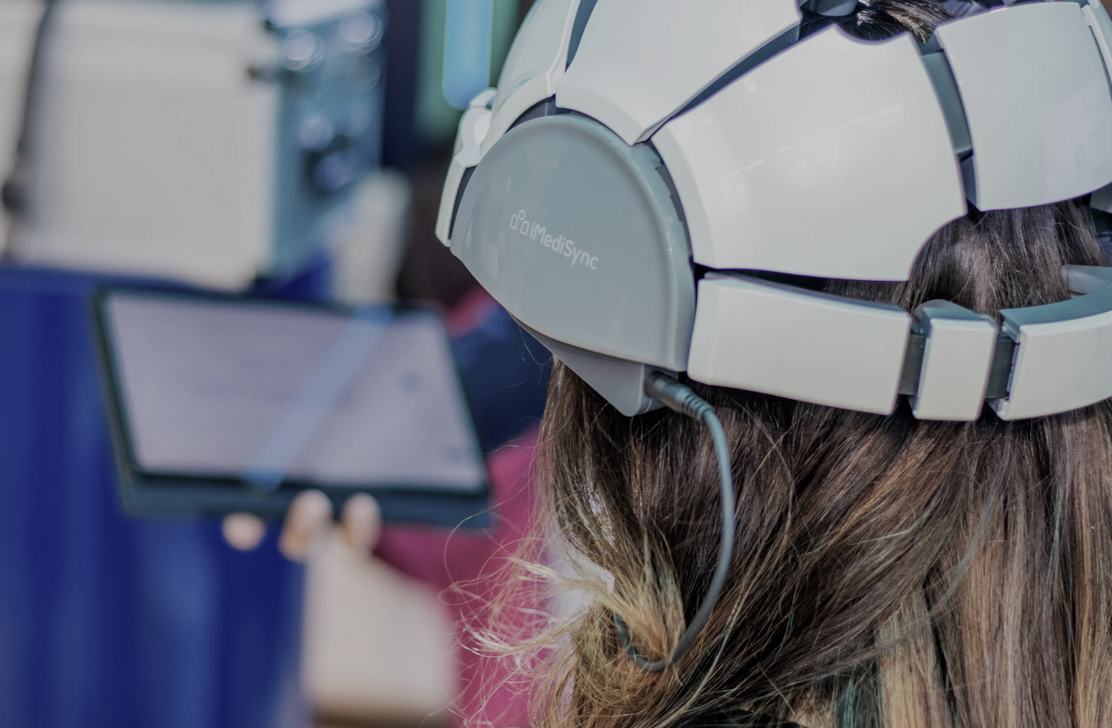Integrating iMediSync Into Your Clinic: What Practitioners Need to Know
Incorporating emerging technologies into clinical work can feel overwhelming—but the right tools can also offer a deeper understanding of your clients and enrich the care you provide. iMediSync’s integrated brain health platform—combining quantitative EEG (qEEG), heart rate variability (HRV) analysis, and transcranial photobiomodulation (tPBM)—offers allied health professionals a way to bring objective, neurophysiological insight into their therapeutic process.
iMediSync can be integrated into a range of clinical or wellness practices, supporting both practitioners and clients in moving toward more targeted and effective interventions.
Why Consider iMediSync?
iMediSync offers a comprehensive brain-body assessment and support system that complements a wide range of therapeutic approaches. Decision-making and client care is supported through:
Objective Data to Complement Clinical Observations
Many mental health and cognitive conditions can present with overlapping symptoms. iSyncBrain’s qEEG analysis and iSyncHeart’s HRV readings provide measurable data to clarify underlying neurophysiological patterns, giving you a more precise foundation to work from.Efficient Screening Tools to Identify Areas of Dysregulation
Within minutes, iMediSync allows you to assess deviations from normative brainwave and autonomic nervous system patterns. These assessments can help identify signs of emotional dysregulation, cognitive decline, sensory processing challenges, or chronic stress—often before clients have full awareness of these issues themselves.Neurotherapeutic Support Tools to Enhance Treatment Outcomes
iSyncWave’s transcranial photobiomodulation (tPBM) offers a non-invasive, brain-based therapeutic option that supports brain health recovery, regulation, and resilience.A More Collaborative and Engaging Therapeutic Process
Brain maps and HRV data give clients a visual, concrete understanding of their symptoms. This fosters insight, increases engagement, and provides a tangible way to track progress over time.
Understanding the Tools
iSyncWave
This is the hardware that forms the physical foundation of the iMediSync system. It is used to:
Record qEEG (quantitative EEG) data via a 19-channel EEG recording device.
Deliver transcranial photobiomodulation (tPBM) via 850nm near-infrared light stimulation targeting any or all of the 19 channels of the 10-20 system at pulse frequencies from 1-45hz.
The dual-function design means clinicians can assess and intervene using the same device, streamlining workflows and increasing accessibility.
iSyncBrain
A cloud-based qEEG analysis platform that compares a client’s brainwave patterns to a large, age- and gender-matched normative database. The resulting reports:
Identify imbalances or abnormalities in brain activity
Highlight patterns associated with conditions such as anxiety, depression, ASD, ADHD, trauma, sleep dysregulation, and cognitive decline
Provide visual maps and graphs that are easy to interpret and share with clients
iSyncHeart
A heart rate variability (HRV) analysis system that measures the balance and adaptability of the autonomic nervous system. This data offers valuable insight into:
Stress resilience
Parasympathetic vs sympathetic dominance
Cardiovascular and nervous system adaptability This is particularly useful when working with clients experiencing chronic stress, trauma, or emotional dysregulation.
How iMediSync Supports Therapeutic Work
1. Adds Clarity to Complex Presentations
Clients often present with a mix of symptoms that defy simple categorisation. For example, fatigue, poor concentration, and anxiety may stem from varying and individual brain activation patterns. qEEG and HRV data allow you to map these patterns and the brain regions involved objectively, supporting more accurate case formulation and treatment planning.
2. Improves Client Engagement and Understanding
The visual, measurable nature of iMediSync assessments can be empowering for clients. When clients see their brain maps or HRV profiles, it externalises their experience and validates their symptoms. This can improve motivation, increase therapeutic buy-in, and offer a new language for self-understanding.
3. Supports Tailored, Neuro-Informed Interventions
Instead of relying solely on symptomatic reports or trial-and-error, you can draw from qEEG and HRV data to choose more targeted interventions—whether that’s a specific psychotherapy modality, somatic work, lifestyle changes, or brain-based therapies like tPBM or neurofeedback.
4. Offers a Brain-Based Therapeutic Option to Optimise Nervous System Health
Transcranial photobiomodulation (tPBM) provides a direct, non-invasive way to support the brain’s self-regulating capacity. Regular sessions can promote neuroplasticity, reduce inflammation, support cognitive clarity, and enhance emotional regulation. For clients not ready or able to engage in talk-based therapies, or those needing nervous system support between sessions, this is a valuable adjunct.
Who is iMediSync for?
iMediSync is currently used by professionals in a wide range of fields, including:
Psychologists and psychotherapists
Integrative and naturopathic doctors
Chiropractors
Melillo Method Practitioners
Occupational therapists and allied health providers
Neurofeedback and biofeedback practitioners
It’s important to note that iMediSync technologies should be used within the practitioner’s scope of training and professional registration. The system is designed to complement—not replace—clinical judgment, and it can be adapted to suit a range of modalities and client populations.
Integrating iMediSync into your practice doesn’t require you to overhaul your approach. Instead, it offers a way to work more precisely, more collaboratively, and more holistically with the clients you already serve.
By combining objective assessment tools with a gentle, brain-based intervention, iMediSync helps you better understand the root of your clients’ struggles—and opens the door to deeper, more sustainable outcomes.


